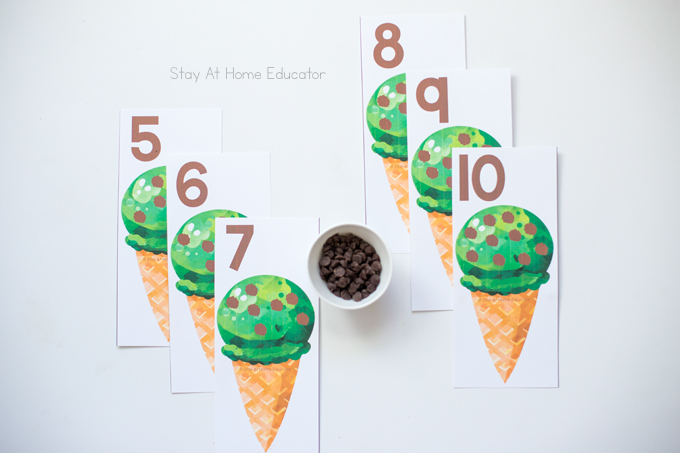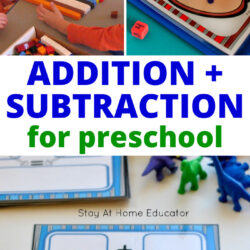This post is packed with tips on how to teach addition for preschoolers in an age-appropriate way. We’ll cover subtraction, too! Preschoolers are natural mathematicians (and love being called as such), so let’s dive into the ultimate guide to teaching addition and subtraction to preschoolers!
A robust preschool math curriculum will include instruction in all five disciplines of math. This includes teaching number sense, which is the discipline that includes addition and subtraction.
What You Need to Know About Teaching Addition and Subtraction to Preschoolers
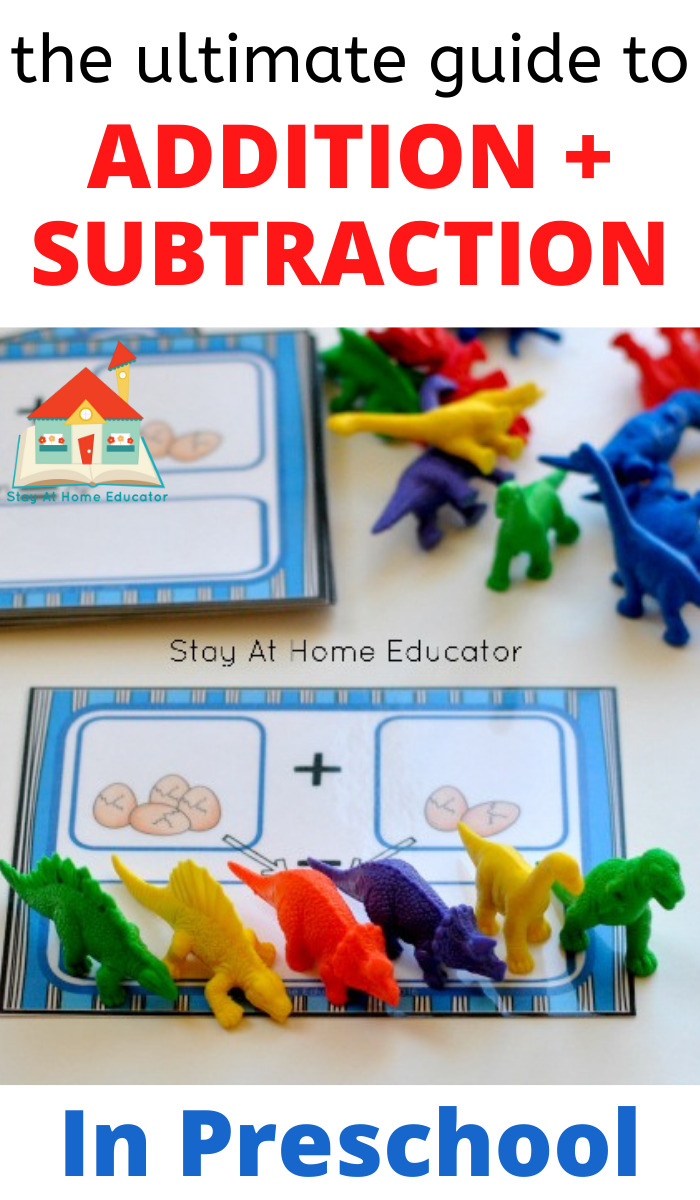
Many educators feel rather confident in teaching their students early mathematics skills such as the basics of number recognition, one-to-one correspondence in counting, sorting activities, and knowledge of shapes. But…what about addition and subtraction?
Exposure to such skills begins at a very young age, before children may even have mastered one-to-one correspondence. This exposure can influence enthusiasm and ease of learning as children get older.
Once preschoolers have established number sense, they are very capable of learning beginning addition concepts. Preschoolers can learn how to add by joining small groups of numbers together or taking small groups apart.
What Are the Prerequisite Skills to Teaching Addition and Subtraction in Preschool?
Teaching addition and subtraction is an increasingly important piece in early childhood education, especially among kindergarten standards.
It’s a fairly typical standard now that preschoolers should be able to identify numbers through ten and rote count to twenty, but now incoming kinder students are expected to know how to do a little adding and subtracting. This means they need to be learning these math skills in developmentally appropriate ways in preschool.
How To Teach Addition and Subtraction Concepts to Preschoolers
When introducing the concept of addition, begin by teaching the concept of “more.” Demonstrate how when we add two groups of items together we always end up with more.
Addition and subtraction scenarios often happen very naturally through play. A child might be playing with two cars. He adds one more car to make three. He then counts all the cars to see the total number of cars has increased.
The child easily understands he now has more cars than when he began. He’s created his own addition game! If some cars are taken away, it’s understood that he now has less.
When introducing subtraction skills to preschoolers, begin by teaching about the concept of less. Demonstrate how when we take some items away from a group, we always end up with less.
When planning for addition and subtraction skills for your preschool classroom, you should include:
- composing five
- composing ten
- decomposing five
- decomposing ten
- identifying equal and non-equal numbers
It’s best to wait to use traditional number sentences and the +/- sign until children show understanding of the concept of simple addition/subtraction with manipulatives and through story problems.
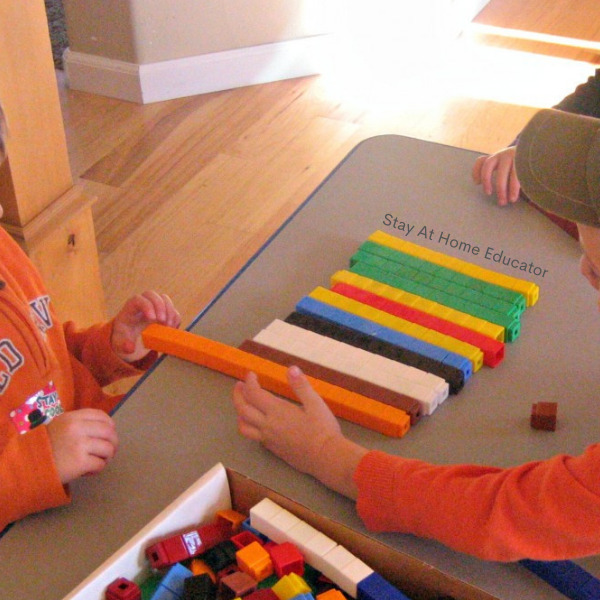
Addition and Subtraction Strategies For Preschoolers
Now, before you worry about developmentally appropriate practices, let me tell you that there are many ways to practice addition and subtraction! In all honestly, you are probably already using some of these strategies.
Draw and Match, Then Draw Again
When first introducing preschoolers to addition and subtraction, I always have them count.
For example, using these bumblebee number cards, invite your preschooler to choose a card and count the number of bumblebees. Use counters to match with those on the cards.
Then point to the number on the card and identify it. Next, draw a second card and follow the same procedure. Now ask your preschooler to count the total number of bumblebees.
Draw and Count On
Using something like our apple number cards, invite your preschooler to pick a card and count the number of apples. Then point to the number on the card and identify it.
Next, pick a second card and follow the same procedure. Finally, ask your preschooler to put the two cards next to each other and “count on” from one card to the next. You might use the following language:
The first card has 1, 2 apples. [Point to each apple as you count]. Let’s keep counting on the second card and see how many we have all together. 3, 4, 5, 6. See? There are two apples in the first box and four apples in the second box, which means we counted six apples all together!
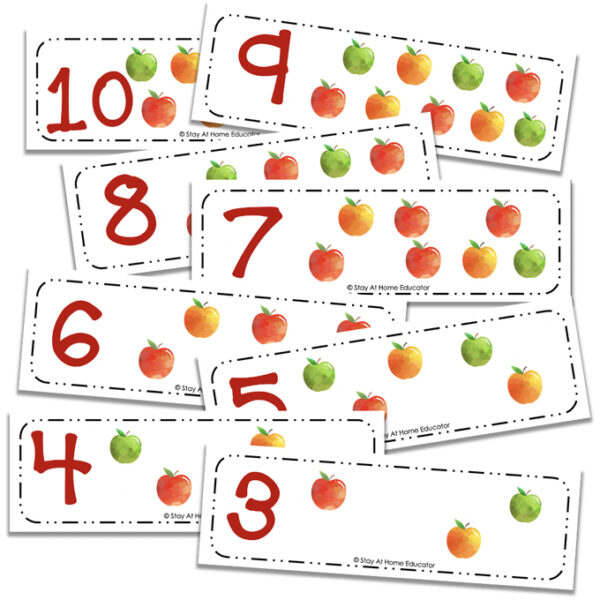
Draw and Tell a Story
One of the best ways to teach addition and subtraction to preschoolers is to use story problems.
Invite your preschoolers to draw an ice cream card. Count the number of chocolate chips and identify the number on the card. Draw a second card and follow the same procedure, or invite another preschooler to do the same.
Set up the cards so that they have several inches between them. Then “put the cards” into a story problem. It might sound like this:
Benson drew an ice cream card that had three chocolate chips. Then Addison drew a card that had five chocolate chips on it. Together Benson and Addison have how many chocolate chips? Let’s count.
You can reinforce this approach and concept by using real chocolate chips or brown pom poms along with the counting cards.
Use Different Manipulatives
It’s important for preschoolers to understand that quantities remain the same regardless of what is being counted. For example, that five crayons is the same amount as five markers, and that’s the same amount as five pencils. Five is always going to be five.
Use the number cards previously used for any of the activities above but replace the bumblebees, apples, or chocolate chips with a variety of different manipulatives. Do the same addition or subtraction problem over and over using different materials, thus reinforcing that the quantity of each number is always the same.
Here are some of the manipulatives we reach for regularly when teaching addition and subtraction.
Formally Teach Addition and Subtraction
You’re still not going to use the words “plus” and “minus” or “equals” unless it comes naturally in your speech.
Invite your preschooler to draw two cards and identify the numbers on each card. Place a plus or minus sign between the two cards, then an equals sign at the end. Essentially, you are creating that formal algorithm in a hands-on way.
Now, invite your preschooler to use manipulatives to count out corresponding numbers and place the manipulatives below each card. Then, show your preschooler how to “read the number sentence.” It might sound like this:
One crayon plus three more crayons equals four crayons. That means if you have one crayon and then you get three more crayons, you end up with four crayons all together.
Notice that in this activity you are modeling for your preschooler what a number sentence might look like, but your focus is still not on the formal mathematical language. Your focus should still remain on the actual concepts of adding (getting more) and subtracting (taking some away).
Tips for Teaching Preschoolers Addition and Subtraction
Let’s start with some tips on teaching preschooler addition and subtraction, because how you teach a preschooler is different from how you teach addition for prek, kindergarten, and first grade.
- Keep activities developmentally appropriate. This means no formal written algorithms or addition worksheets, especially at the beginning of preschool.
- Don’t focus on mathematical jargon. Preschoolers don’t need to know “plus,” “minus,” “equals,” or “solve the problem” unless it comes naturally in your speech.
- First develop number sense skills like counting, number identification, number order, and more and less concepts.
- Teach addition and subtraction to preschoolers abstractly by referring to concepts of “adding more” and “taking some away”.
- Use oral word problems. “You have three apples. If I give you one more apple, how many will you have all together?”
- Always, always, always use manipulatives. Whether the manipulative be fingers, counters, or whatever, use something the children can touch and move around. Hands-on addition is the only way to teach!
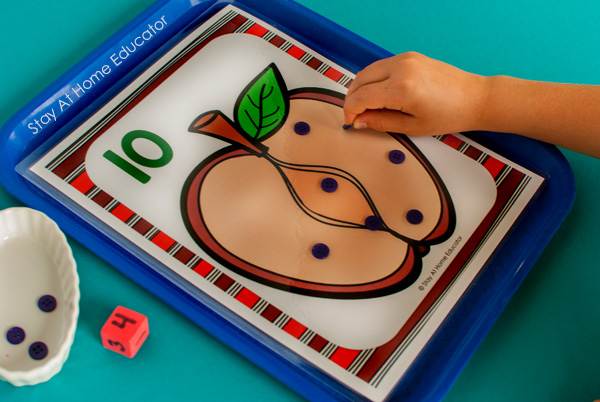
Additional Notes on Teaching Preschoolers Addition and Subtraction
Remember that addition activities in preschool need to be developmentally appropriate. It’s important to understand and recognize a few things in regards to these activities.
- Keep these activities fun and light-hearted, like math games. No pressure on the kiddos, please!
- Start with only one activity and just do it a few times in any one session.
- Recognize that as your preschooler develops basic number sense skills, his addition and subtraction skills will also strengthen.
- I like to use the, “I do. We do. You do.” teaching model. Meaning, that first I demonstrate, then we do it together, and I ask a preschooler to do it (still under my direct supervision).
Get the Daily Lessons in Addition and Subtractions Preschool Unit
Remove any overwhelm from teaching measurement to preschoolers by following these easy, step-by-step addition and subtraction lesson plans. You’ll get four weeks of daily addition and subtraction lessons to do with your preschooler, plus bonus activities, teaching tips, literacy integration activities and even weekly printable preschool math centers.
This unit is systematic, which means the skills progress in a way that is developmentally appropriate for preschoolers. And, everything is hands-on and fun!
-
Product on sale
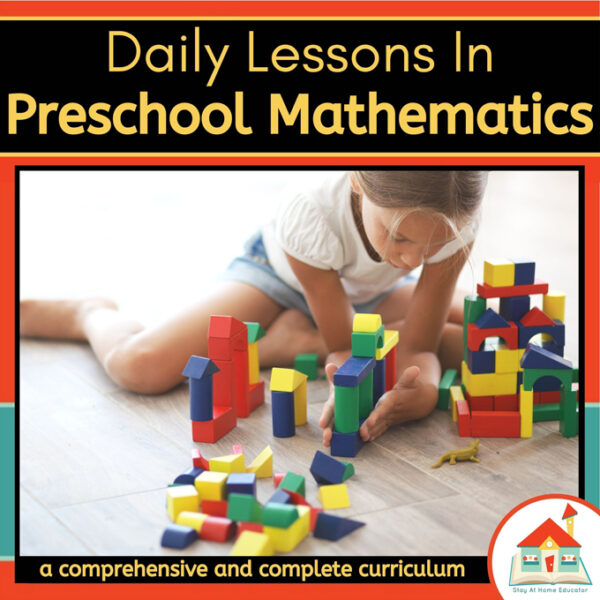 *** Daily Lessons in Preschool Mathematics CurriculumOriginal price was: $135.00.$99.00Current price is: $99.00.
*** Daily Lessons in Preschool Mathematics CurriculumOriginal price was: $135.00.$99.00Current price is: $99.00. -
 Daily Lessons in Addition & Subtraction Preschool Math Unit$16.00
Daily Lessons in Addition & Subtraction Preschool Math Unit$16.00
Each day in the preschool addition and subtraction lesson plans includes review activities and new learning concepts about adding and subtracting. Concepts of this unit include learning more and less, increasing and decreasing quantities, number sequencing (order), and composing/decomposing within 5 and 10.
Preschool Addition and Subtraction Activities
Use Picture Books!
Another amazing resource for teaching addition and subtraction to preschoolers is picture books! These age-appropriate books break down the large concepts of more and less into simple, relatable material. Here are some of our classroom favorites!
The Secret to Teaching Math to Preschoolers
Teaching math is an enormous task, and with the new changes in adopted state standards the bar for teachers has risen even higher.
That’s because there is a lot that goes into teaching math.
It’s comprehensive and systematic. And addition and subtraction is only one piece of the puzzle.
Mathematicians indicate there are five disciplines of math (like mentioned above) that should be taught, which are as follows:
- number sense – the development of a deep understanding of numbers and the number system, to compose and decompose numbers and understand their various relationships
- algebra – the understanding of patterns and relationships, including sorting and categorizing
- geometry – the understanding of spatial relationships, prepositional terms, and the properties of two and three-dimensional shapes
- measurement – the ability to make comparisons and order, understanding measurable attributes
- data analysis and probability – understanding data as a means of sharing organized information and understanding that certain variables affect data
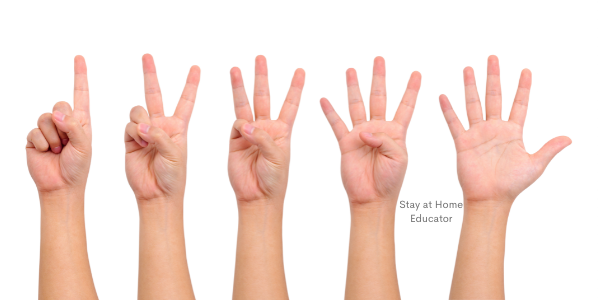
Get Daily Lessons in Preschool Mathematics
This Preschool Math Curriculum is designed to teach your preschooler all five disciplines of math without the boring worksheets!
Including nine individual math units, the Preschool Math Curriculum is systematically designed. No need to wonder how to approach preschool math, this curriculum lays it out for you but is flexible enough to be tweaked for the needs of your students.
Included are 40 weeks of math instruction, featuring over 325 new and unique hands-on activities. And, that doesn’t even include the 72 printable and reusable centers to support a play-based instructional approach.
-
Product on sale
 *** Daily Lessons in Preschool Mathematics CurriculumOriginal price was: $135.00.$99.00Current price is: $99.00.
*** Daily Lessons in Preschool Mathematics CurriculumOriginal price was: $135.00.$99.00Current price is: $99.00.

I’m Sarah, an educator turned stay-at-home-mama of five! I’m the owner and creator of Stay At Home Educator, a website about intentional teaching and purposeful learning in the early childhood years. I’ve taught a range of levels, from preschool to college and a little bit of everything in between. Right now my focus is teaching my children and running a preschool from my home. Credentials include: Bachelors in Art, Masters in Curriculum and Instruction.
